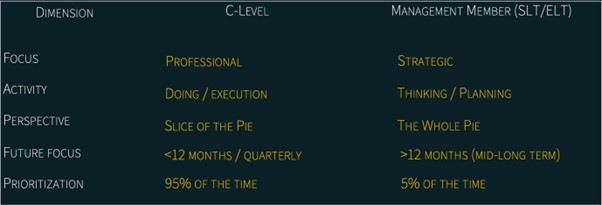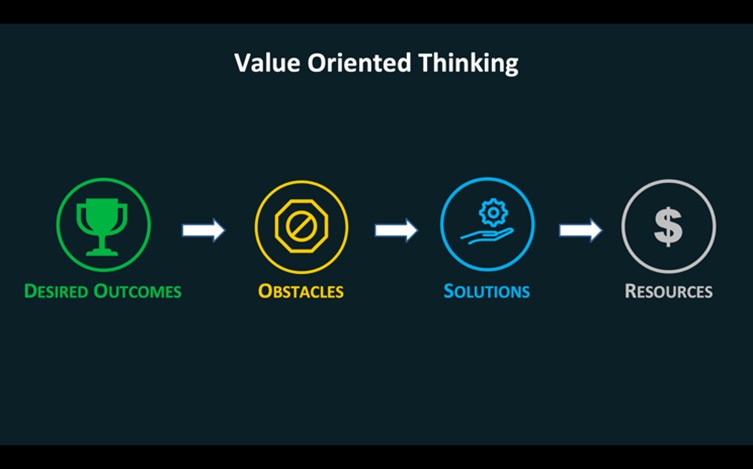
Senior executive leadership teams (ELT) operate in all sorts of companies, from hyper- growth startups that have reached “unicorn” status to well-established global corporations. Yet in spite of the impressive experience and talents of the individuals who populate them, ELTs often achieve less than one would expect.
In my work with dozens of companies around the world, I’ve identified four issues that have a negative impact on ELT performance.
- Multiple Identities
ELT members almost always carry at least one C-Level title in addition to their ELT title. In fact, it’s their C-Level title that makes them eligible for membership on the company’s senior-most leadership team. What is frequently not recognized or acknowledged is that each of these titles represents not only different roles and responsibilities but often conflicting ones.

For the vast majority of their time, ELT members are engaged in tasks that fall under their C-Level hat. So is it any wonder that they forget to “change hats” when participating in management meetings or executive leadership off-sites? Often, this leads to tugs-of-war, dragging these meetings down to tactical discussions and short-term focus – when in fact, the single most important role of the CEO’s senior level management team is to think beyond short-term, departmental perspectives and consider the company’s path forward as a single entity.
Just to clarify, ELTs must certainly spend time sharing updates, putting out fires and discussing ongoing tactics – but in my opinion, this is not their most important function in the company; rather, it is to be critical mid-to-long-term strategic decision-makers.
- Not Enough Time to Think
In their C-level roles, ELT Members often spend most of their time knee deep in execution – often as another player on the field so to speak rather than as the head coach of their respective departments. So when they manage to break away and convene for management meetings, they show up relatively unprepared, having spent insufficient time reviewing materials sent ahead of the meeting… actually, in too many cases, such prep materials are not even circulated.
- Not Thinking Optimally
Sadly, even when time is set aside to think, it is often not used effectively.
I have had the pleasure and privilege of working with many of the world’s most veteran and capable executive leaders. Yet even they are not immune to the internal biases and external distractions that plague us all. Often they do not properly define desired outcomes and success metrics (“Value Oriented Mindset”) to serve as focal points against which alternatives can be weighed and compared. Instead, they are preoccupied with the challenges of insufficient resources (“Resource Oriented Mindset”), and pressing deadlines(“Solution Oriented Mindset”).
Rational decision making has a formula, no matter the industry or the product or service. It involves a very specific logical sequence of questions, each focusing on a different strategic component:
Desired Outcomes / Value Creation: “What is the future state we wish to achieve?”
Obstacles: “What is likely to prevent us from achieving this desired future state?”
Solutions: “What are some of the ways to overcome these obstacles?”
Resources: “What will we need in order to fuel/execute the solutions we select?”

Simple and straightforward though these questions may seem, it is truly remarkable how common it is to mistake a solution for a value, or a lack of resources for an obstacle, or even obstacles for solutions. At the heart of being great decision makers lies the ability to address these four questions in the right logical sequence and not to confuse one with another.
- Sub-optimal Management Meetings
When the executive leadership team gets together, it is composed of the most senior individuals in the company, representing vast cumulative years of experience and a 360 view of the company. As such, it constitutes the most expensive and precious time invested by the company. And yet…
The vast majority of ELT meetings are not focused on analysis and decision making but rather on status updates and tactical issues that are rarely relevant to most ELT members, sending them to their emails and Slack messages during agenda items in which they see little value.
- Agenda items are selected from week to week and published only scant days (if not hours) in advance. This does not allow sufficient preparation time which in turn undermines the quality of the discussions during the meetings and in turn the team’s ability to make decisive decisions.
- Often goals are not set for each agenda item’s discussion or for the meeting as a whole and it seems as if each meeting stands in its own right, with little connection to previous ones. This makes it harder to ensure that the discussion remains on track or to evaluate at the end of the discussion if it was impactful – again undermining the team’s ability to make decisive decisions.
- What’s more, preceding meetings often lack proper follow-up of agreed upon action items. This lowers the ELT member’s appreciation for the discussion (and its conclusions), as there is no sense of accountability (“Why take it seriously if nothing will be acted upon anyway?”)
To sum up – these meetings all too often seem almost unintentional and very tactical, with many of the following questions never discussed or resolved:
- How frequently should ELT meetings be held?
- What constitutes a strategic agenda item in the company?
- What is the right balance between status updates and strategic discussions?
- What preparation should be required (and reasonably expected) for each ELT meeting?
- What should the ELT meeting format be? How can follow-up ownership be ensured?
Finally, due to the nature of the strong personality types of the ELT members, and the urgent nature of the topics commonly being discussed, lack of time management often leads to suboptimal discussions and agenda items never being reached.
What Can Be Done
This is precisely why professional moderation can provide an appealing value-for-money proposition – especially since a good moderator can establish self-sustaining dynamics and best practices within three to six months and then leave.
Role of the moderator
- Time management
- Structure and flow (connecting the dots, making sure the right questions are asked)
- Impactful conversations (ensuring that each discussion ends with clear conclusions or actions items linked to owners and deadlines).
- Full and amicable discussion following these rules of engagement:
- It’s not about what’s possible… it’s about what’s necessary given the business model adopted by the company
- Strive for rationality
- Have strong opinions, loosely held (you can make bombastic statements, and everyone should implicitly assume that you’ll happily change your mind in a heartbeat if new data suggests you are wrong).
- Be tough on the issue but soft on the person.
- Disagree and commit
- Listen to the moderator!
In conclusion, I want to be clear that not all management teams suffer from all of these weaknesses. Maybe yours doesn’t suffer from any of them. If so, I expect your company will reach inspiring heights. This article is offered as a guide for what to look for if and when you feel that your executive leadership team is not operating at the level it could be.
If you liked this article you may find these interesting as well:

Winter is coming – Strategies that can help you grow even during the budgetary policies of a recession
Ariel Halevi | 12 minutes They’re cutting your budget and telling you that they still expect you to meet your goals. Financial growth without budgetary

Dealing with Post-Covid Employment Disorder – A Different Approach to the Current Workforce Crisis
Photo by Parastoo Maleki on Unsplash Ariel Halevi | 5 minutes Over the past year, there’s been a hiring and talent retention crisis. Massive resignations,

How Healthy is Your Organization’s “Invisible Glue?”
Ariel Halevi | 10 minutes Imagine the day Antonie Philips van Leeuwenhoek looked through his innovation’s lens and became the first human being to see

